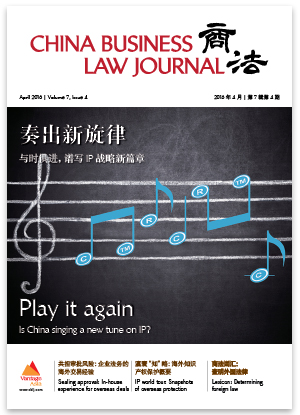Doing business without risk is a utopian idea. In the real commercial world, almost every decision somehow comes down to weighing benefits against risks. Finding the right protection is therefore a must-have capability for success.
This issue of China Business Law Journal first looks at how to safeguard your intellectual property (IP). In Play it again, we approached IP managers for their views on the development of China’s IP protection regime and the challenges that remain. China has moved into a so-called “IP era”, as the protection of IP rights and public knowledge regarding intangible assets have reached new heights.
IP has become a key word high on the central government’s agenda. Last December, the State Council released a document about building China into a strong IP nation. In March, Premier Li Keqiang emphasized innovation and IP protection in his government work report. IP has gained momentum in the top policy-making echelons of government.
Meanwhile, complexity has increased, as more IP elements are considered. The case with John Deere’s colour combination trademark was the first of its kind since colours became a category under the protection of the Trademark Law in 2001. More relationships need to be considered. Besides external parties, companies also have to make proper arrangements with internal staff over service inventions. And finally, more regulatory concerns are involved. The trade-off between patent protection and antitrust enforcement has plagued regulators and caused uncertainty for patentees.
IP is also increasingly crucial for Chinese investors in overseas markets. IP world tour takes you on a journey around the world, complete with snapshots of IP issues in some of the world’s hotspots for Chinese investment including Europe, North America, Latin America and Asia-Pacific. Significant trademark reforms in Europe have recently taken effect, bringing changes to trademark applications and the fee system. Major trademark challenges in the US include social media and online infringements, while the Trans Pacific Partnership (TPP) agreement has triggered or will bring revisions to IP systems in some countries across the ocean. Coming up to speed with overseas IP updates should help keep risks at bay.
This increasing demand for overseas IP protection partly springs from a surge in Chinese outbound transactions. In addition to IP, another challenge with outbound M&A has been how to manage government approval risk.
Sealing approval finds that this problem had long haunted Chinese overseas investors, especially the state-run companies. Chinese parties usually had to spend loads of effort negotiating the allocation of those approval risks. But changes have taken place since the central government embarked on a wave of regulatory simplification and authority delegation in 2014. Both foreign and Chinese parties now seem more willing to accept each other’s requirements in negotiations.






















